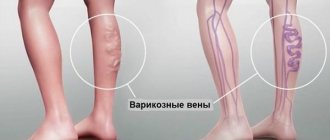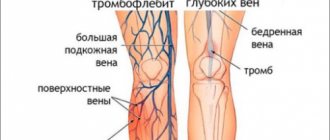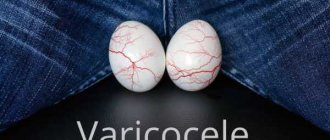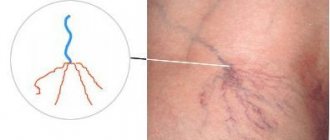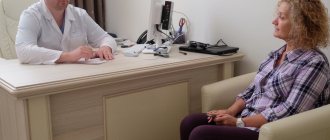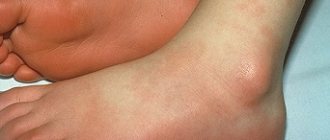Symptoms of varicose veins today are not a secret for modern people in Moscow. Many online resources on the Internet, state television, and simply complaints from friends sometimes provide comprehensive information about the symptoms of varicose veins. And there is nothing strange about this. Varicose veins of the lower extremities are one of the most common modern diseases of mankind.
Manifestations of varicose veins
According to government statistics, 10% of men and about 30% of women suffer from varicose veins. The symptoms of varicose veins in Moscow, the Moscow region, the European part of Russia and other regions of our country will be similar.
Modern phlebology identifies the following manifestations of varicose veins.
Symptoms depending on the stage of the disease
Of course, it should be noted that the stage of development of the disease, the rate of progression, and existing complications (such as decompensation of venous outflow, thrombosis, varicothrombophlebitis, trophic ulcers), which are purely individual for each patient, are of great importance. Depending on the above, the optimal treatment option is selected.
The leading symptoms of varicose veins of the lower extremities are: swelling of the legs at the end of the working day, reticular veins - visually dilated saphenous veins, telangiectasias (in colloquial language - “spider veins”). For a long time, varicose veins manifest themselves only as a cosmetic defect - the presence of reticular veins, varicose veins (varix, lat. - node), however, it should be noted that the further development of varicose veins leads to the appearance of much more formidable symptoms and complications, such as pain, swelling of the feet and legs, and in advanced stages can lead to pigmentation of the skin of the legs (usually the internal surfaces), trophic ulcers, thrombosis, and varicothrombophlebitis.
The appearance of lumps on the veins
Varicose veins can progress in different ways - slowly or quickly. This process is accompanied by the appearance of new varicose veins, which look like bumps, protrusions on the skin in the area of the dilated vein. As they develop, varicose veins can be complicated by inflammation of the venous wall and the formation of a blood clot that clogs its lumen. The larger the size of the varicose vein, the higher the likelihood of a blood clot forming.
Many people imagine a blood clot as something separate, as a piece of something. It is not always so. If a blood clot forms in the lumen of the vein, then the already slow blood flow is blocked. It turns out that the vein turns into a blocked tube, and the blood above the blockage begins to clot. Thrombotic masses increase their length, the entire vein above the site of initial blockage is thrombosed.
If you do not seek professional medical help, thrombophlebitis becomes ascending. And since the saphenous veins connect to the deep veins, thrombotic masses can “grow” to them and at this stage a piece of the blood clot can break off and enter the heart and further into the pulmonary artery.
Why do we need modern diagnostics even in the absence of obvious symptoms of varicose veins?
Varicose veins of the lower extremities are unique in that pain is present only in the early stages of the development of this disease, and as the walls of the veins thicken, they are reduced to almost nothing. For a long time, a person may simply not notice varicose veins. The first symptoms of serious varicose veins are pain in the calf muscles, a feeling of heaviness and burning, swelling, itching, as well as darkening and thickening of the skin of the lower leg. Thus, in advanced stages of varicose veins, the symptoms of complications of varicose veins already take the leading role in the symptoms. Therefore, a preventive visit to a good European-level phlebologist in Moscow is the best way to avoid these complications.
Causes of varicose veins
Blood circulates continuously in the human body; the heart, veins and arteries take a direct and constant part in this movement. Through arteries, blood moves from top to bottom, through veins, on the contrary, from bottom to top, to the heart. The blood moves upward in spurts, fixing itself in the places where the valves are located, and the valves, in turn, prevent the blood from returning back down. Thus, blood moves freely from one valve to another.
This movement of blood occurs with proper and complete functioning of the muscles of the lower extremities. But if the valve does not contract enough, then some of the blood returns down, which leads to an increase in venous pressure and subsequent dilation of the veins. The result is stagnation of blood in the veins.
What could cause valve malfunction?
The reasons may be both external factors and genetic disposition. The veins contract with the help of the muscles located around them. If a person has a sedentary lifestyle or a job that requires constant sitting, such as driving a car or office work, then the muscles become inactive and weak, which leads to poor circulation and, accordingly, to venous diseases.
External factors and causes of varicose veins can be:
- excess weight
- pregnancy
- taking hormonal medications
- menopause
- loads on the lower limbs
- sedentary lifestyle
- work that requires constant sitting (driving a car, office work)
- work that requires constant standing without the possibility of rest or change of body position (surgeons, teachers, salespeople)
- frequent wearing of high-heeled shoes
- wearing tight underwear
- Frequent carrying of heavy bags
- chronic digestive disorders (constipation)
— various concomitant chronic diseases (diabetes, cardiovascular diseases, kidney diseases)
Innovative treatment of varicose veins at various stages in the center of Moscow
During the consultation, an individual treatment regimen is selected for each patient suffering from varicose veins of the lower extremities, taking into account the stage of the disease. In the early stages, medical conservative treatment with the use of medications, electromyostimulators, compression stockings and sclerotherapy is quite sufficient. Modern treatment of varicose veins in the early stages of pathology can be implemented by gluing veins. For this purpose, one of the best medical techniques used today is sclerotherapy, the essence of which is the removal of dilated veins by introducing into them special drugs, the so-called sclerosants. In advanced stages of varicose veins that are not amenable to conservative treatment, non-surgical treatment is performed ( Venefit™ RFO procedure
or EVLO
).
Treatment of symptoms of varicose veins with thermal methods in our center
These innovative techniques are currently the leading, most advanced and are used in the best phlebological centers around the world, including Moscow and the Moscow region. Good phlebologists often supplement the procedure of radiofrequency (RFO) or laser obliteration (EVLO) of the saphenous veins with miniphlebectomy and scleroobliteration using the Foam-Form method.
Methods for treating itching
After a thorough examination and identification of varicose veins, a phlebologist in most cases will prescribe comprehensive treatment to the patient.
- The veins behind the knee hurt
Medications
For vein disease and if the veins in the arms and legs itch, the following medications help:
- Preventing the appearance of blood clots: Heparin, Warfarin.
- Ensuring the dissolution of blood clots: Streptokinase, Fibrinolysin.
- Relieving pain and reducing burning: Cetrin, Finistil.
- Calming character: Novopassit.
- Vitamins that improve blood circulation processes in general: Supradin.
- Normalizing the functionality of blood vessels: Detralex.
Why you shouldn’t delay treatment when symptoms of varicose veins appear
It should be noted that the degree of overstretching of the veins in each individual case is different, and therefore the consequences of varicose veins are not always possible to predict. Among the most common complications are thrombophlebitis, trophic ulcers, as well as bleeding and thromboembolism with irreparable consequences.
As for surgical intervention, it is usually resorted to in advanced cases. Among all the currently existing surgical techniques, modern miniphlebectomy and innovative endovasal methods of vein obliteration stand out. Much attention should be paid to the prevention of varicose veins. For this purpose, it is better to seek advice from a good phlebologist in Moscow. Do not self-medicate under any circumstances. The consequences can be very sad.
Prevention of varicose veins
There is no way to completely prevent varicose veins. But improving circulation and muscle tone can reduce the risk of developing varicose veins. Measures to treat discomfort from varicose veins at home:
- Gymnastics
- Maintaining an optimal body mass index
- High fiber, low salt diet
- Avoid high heels, tight hosiery and other tight clothing
- Leg Raising
- Change your sitting or standing position regularly
Well, it's time to move.
Rituals for good prospects
The following rituals will help enhance the positive impact of signs:
- Speak out loud to throw out all the accumulated negative energy.
- Write down all your negative thoughts on a piece of paper. After this, the sheet of paper must be burned.
You can also break several plates, while talking through all your accumulated experiences.
Many people experience itchy wrists. Most often it itches for a reason. To understand the reasons for the appearance of such itching, you need to familiarize yourself with the basic interpretations of such a sign.
What causes itchy legs with varicose veins?
Itchy legs with varicose veins are associated with dry skin. Dilated veins cannot provide proper nutrition and blood circulation to the tissues. As a result, the skin, muscles and other tissues suffer from trophic changes and oxygen starvation.
Due to insufficient blood supply, the skin on the lower extremities becomes dry, rough and dark in color. Thinning skin ceases to perform a barrier function. Small cracks and wounds appear on the legs.
Dry skin causes discomfort in the form of itching and burning. Scratching your feet in this state leads to possible infection, since an infectious agent can get into the cracks. This is why itching of the legs with varicose veins is dangerous.
Using elastic bandages for varicose veins
Currently, there are not many situations where modern experts recommend compression bandages, but still in some clinical cases this is not without meaning.
Compression bands can be adjusted to achieve different levels of pressure, which is both an advantage and a significant disadvantage. Even medical workers do not always apply compression bandages correctly, which leads to undesirable effects. What can we say about ordinary patients? In situations with unstable edema, compression bandages may have a better effect than compression stockings. The difficulty lies in applying compression bandages, which is best left to professionals. Otherwise, the target effect of compression therapy may not be achieved. And in the worst case scenario, complications arise from the improper use of compression bandages. Therefore, in the vast majority of cases, modern specialists choose compression hosiery as a more controlled and universal means of helping patients with varicose veins.
Allergy
Many allergic reactions, such as those caused by insect bites, involve redness and swelling of the skin. In case of allergies, the patient usually complains of redness and itching on the legs. With the onset of the warm season, you need to especially carefully monitor your condition: insects may be hiding in the grass. In case of a severe reaction, unpleasant symptoms can be relieved by taking an antihistamine. If you leave allergies unattended, getting rid of unpleasant symptoms will take a very long time.
How to choose compression hosiery for varicose veins
Once you have determined the required level of compression with your healthcare provider, you will need to purchase a specific product.
The best compression stocking available today
Leading criteria for choosing compression hosiery:
- Length of compression product. Varicose veins can occur both only on the legs and throughout the entire lower limb. The location of your varicose veins will influence which type of compression garment you should choose. If you have varicose veins only within the shins, then you should pay attention to knee-length compression socks. If varicose veins are on the legs and thighs, then groin-length stockings will be the best choice. Some patients in this case prefer compression tights.
- Choosing the size of compression hosiery. This aspect can be entrusted to specialists in a specialized salon or you can measure the parameters of the lower limb yourself. In the latter case, you may need to measure the circumference of your ankle, calf and/or thigh. On your own or with the help of a specialist, you will need to compare the measurement data with the size table to find your personal size. Choosing the right compression garment size is very important: if it is too small or large, the compression stockings will not provide the right level of pressure. This will lead to the ineffectiveness of compression therapy or the impossibility of using hosiery.
- Choosing a compression product style. The modern compression products industry offers a wide selection of fabrics, styles and product shapes. You need to make a choice between opaque or transparent fabric, the presence or absence of a pattern, closed or open toe. You will also need to choose a color, which varies from product to product. Basic neutral colors such as black, beige and white are almost always available. Certain types of compression products are presented in bright solid colors, and there are options with various patterns.
When and which doctor to contact
Usually a doctor is consulted:
- if the rash spreads over a large area;
- when symptoms increase;
- when signs of general intoxication occur;
- if the urticaria does not go away on its own after eliminating the factor that caused it;
- if the disease becomes chronic or often recurs,
It is advisable not to delay your visit to the doctor and come when the first manifestations of the disease occur. Then it will be easier to establish the cause, and treatment will take less time. In addition, the doctor will recommend what to do to prevent hives.
A therapist or pediatrician, a dermatologist can provide assistance with urticaria, and an allergist is involved in targeted diagnosis and treatment.
Types of urticaria
There are several classifications of urticaria.
1. By time:
- acute – lasts up to 6 weeks;
- chronic – more than 6 weeks.
2. By nature:
- allergic (immune) - realized through the development of an immune reaction, often combined with other allergic diseases (bronchial asthma, rhinitis, conjunctivitis, dermatitis, etc.);
- non-allergic - through the direct release of histamine.
3. Due to:
— allergic urticaria
may cause:
- Food;
- taking medications;
- insect allergens (insect allergy);
- pollen allergens.
— non-allergic
form of the disease occurs due to a direct effect on the mast cell:
- physical factors - such as cold, heat, ultraviolet radiation, radiation, vibration, compression;
- chemical (provoking factors are solvents, acids, alkalis and other chemicals);
- certain medicines, such as aspirin;
- infectious agents - viruses (adenoviruses, Epstein-Bar virus, enteroviruses), streptococci, helminths, Helicobacter pylori;
- for systemic and other chronic diseases (rheumatoid arthritis, systemic lupus erythematosus);
- with a sharp increase in the level of histamine and other active substances in the blood due to the large consumption of foods high in them: eggplants, canned food, nuts, bananas, chocolate and others.
Hereditary, psychogenic, and idiopathic urticaria (this is the name for a disease whose cause has not been established) is also possible.
The wide variety of factors and similar developmental mechanisms of individual species make it difficult to find the cause. Most often, this requires the help of a specialist.
Interpretation by days of the week
To figure out why a girl or guy’s left wrist itches, you need to familiarize yourself with the interpretation of signs by day of the week:
- Monday. If you start itching on the first day of the week, it means you will soon have to meet new people or go visit friends.
- Tuesday. Itching portends that minor difficulties will arise at work, due to which there will be a delay in wages.
- Wednesday. If you itch on Wednesday, a quarrel with your lover is expected. Conflict can lead to the breakdown of relationships.
- Thursday. Itching on Thursdays is a good sign. The person is expecting a salary increase.
- Friday. If a guy or girl’s hand itches on Fridays, it means they’ll soon have to go on a long trip.
- Saturday. A person will expect unexpected meetings and acquaintances that will radically change his life for the better.
- Sunday. Soon I will have to go on a business trip for a while.
Itching that appears on Sunday night foreshadows separation from a loved one.
Diagnostic procedures for urticaria
Diagnosis of acute urticaria is usually quite simple. An examination and questioning of the patient about his medical history is sufficient. Finding out the reason is not so easy, and for this purpose additional research is carried out:
1. Laboratory tests:
- general blood and urine analysis;
- blood biochemistry (liver tests - ALT, AST, bilirubin, rheumatic tests, blood glucose);
- stool examination (coprogram);
- bacterial cultures from the nasal and pharyngeal mucosa.
2. Instrumental research:
- chest x-ray;
- Ultrasound of the abdominal organs;
- endoscopic examinations of the upper and lower gastrointestinal tract (gastroscopy, colonoscopy).
3. Allergy tests:
- intradermal tests with allergens;
- cold and heat tests;
- physical stress tests, line drawing, tourniquet application.
4. Immunological methods.
5. Consultations of related specialists:
- gastroenterologist;
- endocrinologist;
- rheumatologist;
- gynecologist and others as necessary.
First of all, it is important for a specialist to establish what nature the urticaria is – allergic or non-allergic. In the allergic form, one can clearly trace the connection between the symptoms and the introduction of the allergen. It is confirmed by skin, allergy and immunological tests.
Compression therapy for varicose veins (mechanism of action)
Compression therapy for varicose veins helps to apply a certain pressure on the blood vessels, preventing the accumulation of blood and promoting proper one-way blood flow. Compression stockings can also help manage swelling, especially if you wear compression stockings in the morning before you begin physical activity, which is when leg swelling occurs. The dense tissue prevents the veins from expanding as usual, which helps blood flow faster. Thanks to the combination of these effects, compression stockings for varicose veins can help relieve soreness, aching sensations, as well as muscle throbbing and spasms. However, you should discuss the use of compression stockings with your doctor to avoid possible side effects and complications.
The mechanism of action of compression hosiery for varicose veins
If you already have varicose veins, compression stockings can help relieve symptoms and improve the appearance of your lower legs. In modern practice, compression products of varying degrees of compression, and therefore clinical effect, are used.
- Compression stockings class 1, 15-20 mm Hg. They provide moderate compression and are recommended for prophylaxis in healthy people, as well as in case the patient refuses a higher level of compression.
- Level 2 compression, 20-30 mm Hg, is more effective and relevant for patients with varicose veins.
- 3rd compression level, 30-40 mm Hg. Art., provides significant pressure. In some clinical situations it will be the most appropriate.
- 4th compression level, 40-50 mm Hg. Art. This knitwear is used in selected clinical cases under close medical supervision.

